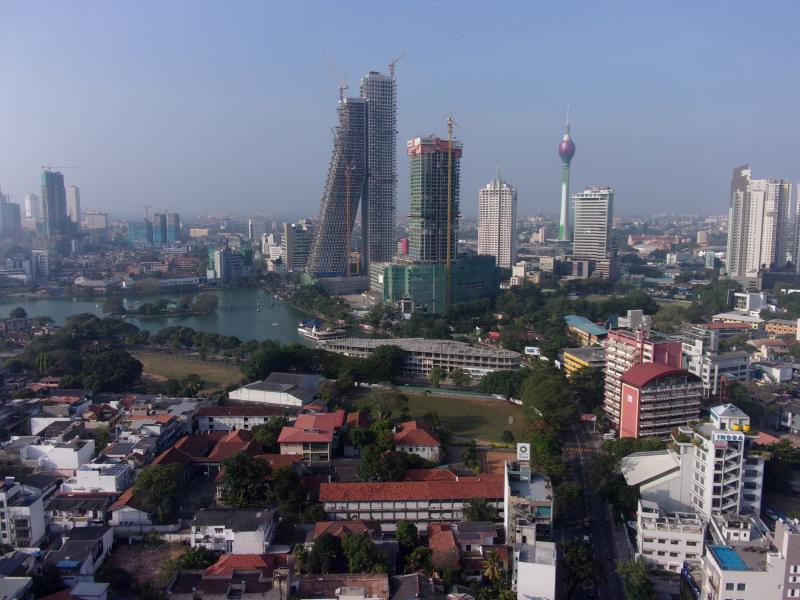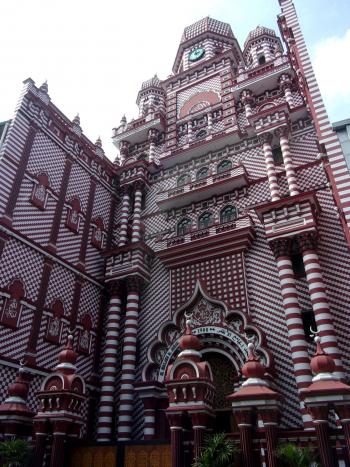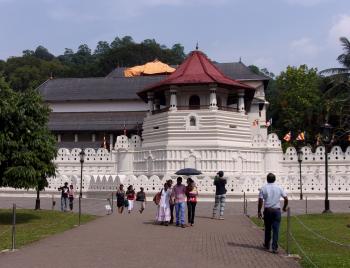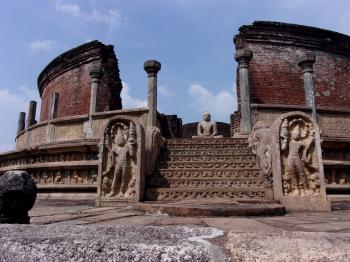Sri Lanka - a World Heritage haven
This article appears on page 16 of the August 2018 issue.
I have been fortunate to travel to many areas of the world that are renowned for their ancient cultures or scenic beauty and are designated as World Heritage Sites by UNESCO (United Nations Educational, Scientific & Cultural Organization). Somehow, however, the offerings of the island nation of Sri Lanka, situated off the southern coast of India, managed to escape my attention until recently, when two of my travel forum correspondents infused me with their enthusiasm as they planned their own tours there.
Sri Lanka is endowed with eight UNESCO sites — an amazing number for a country of this size — and I was privileged to visit five of them during my private tour in January 2018.
Planning a visit
Sri Lanka, until fairly recently, has not been an easy place for travelers to visit. Plagued by a brutal, 26-year-long civil war, Sri Lanka began to reappear on tour providers’ itineraries following the end of the conflict in 2009, when the country’s remarkable sites were once again available to travelers.
I decided to book a private tour in order to allow the most flexibility and the inclusion of sites that were of special interest to me. Go Tours Lanka (www.gotourslanka.com), based in Kandy, Sri Lanka, created an amazing itinerary for me that was customized according to my specific desires.
My 8-day program cost $700, not including hotels, meals or entrance fees. I opted to book my accommodations on my own in order to ensure the quality and location that I wanted at each stop. The tour cost did include transportation and full guide services in (excellent) English at all of the places on the agreed-upon itinerary.
Ruwan Wijerathne, the founder of Go Tours Lanka, personally escorted me. His services as a guide were enhanced by his professionalism, extensive knowledge, friendly support and interesting conversation.
We traveled in a comfortable, air-conditioned Toyota sedan on a program that included the Golden Temple of Dambulla, the ancient cities of Sigiriya and Polonnaruwa, the Sacred City of Kandy and the Old Town of Galle. All five of these places are UNESCO sites, and deservedly so.
Upon my arrival in Sri Lanka (at 1:30 a.m.) at Colombo’s Bandaranaike International Airport, Ruwan met me and we drove to Dickman Resort (www.dickmanresort.com) in Negombo, about 20 minutes from the airport.
Negombo is a pleasant seaside community with an interesting historical center. Many tour providers feel that Negombo provides a more comfortable transition into Sri Lanka for a first night’s stay rather than jumping straight into the hustle and bustle of Colombo.
Dickman Resort was a lovely, secluded, adults-only property off the main beachfront road a short way along a winding back street of Negombo. My hotel rate was $110 per night, including a customized breakfast on a sunny terrace.
During the drive from Negombo to Dambulla, we stopped at Pinnawala Elephant Orphanage, an orphanage and nursery for wild Asian elephants. I got to see the elephants being bathed by their dedicated and adoring mahouts.
Challenging sites
At Dambulla, we climbed many stairs to reach the cave monastery there with its five sanctuaries. The murals, statuary, paintings and awesome color contrasts in each sanctuary were a joy to behold.
It was quite a physical effort for me to reach the cave monastery (I’m completely out of shape and normally sedentary), but the site is fantastic, and I would have been devastated to miss it.
At the Ancient City of Sigiriya, the climb to the top of the rock fortress proved to be an unrealistic goal for me. I had hoped to make it at least halfway up, where the famous maiden frescoes and the Lion’s Gate are located. Alas, even this more modest goal was beyond my capabilities. Luckily, there was an excellent museum at the foot of the rock. Its displays included detailed copies of the maiden frescoes presented in an area designed to simulate the actual site.
Polonnaruwa is the site of one of two abandoned ancient royal cities in central Sri Lanka. (Anuradhapura is the other one.) Polonnaruwa is considered by many experts to be the best preserved of the two sites.
The Royal Palace, the Sacred Quadrangle and Gal Vihara (with its beautiful group of Buddha carvings, a high point of Sinhalese rock carving) are among the fascinating sections of this ancient city that you should be sure to visit.
For the Dambulla-Sigiriya-Polonnaruwa portion of the tour, I based myself at Hotel Sigiriya (www.serendibleisure.com/hotelsigiriya), an older but well-maintained hotel with large rooms ($93 per night). The view from its terrace, across the pool, to the Sigiriya Rock Fortress was terrific.
The terrace restaurant served a bountiful buffet breakfast (included), and dinner was offered on either a buffet or an à la carte basis.
Kandy
The entire city of Kandy, Sri Lanka’s cultural capital, is designated by UNESCO under the name Sacred City of Kandy. The highlight is the Temple of the Sacred Tooth Relic, where a tooth of the Buddha (said to have been smuggled from Buddha’s funeral pyre in 483 BC) is lovingly preserved in a magnificent setting.
But there are also many other sites in Kandy that are “musts.” A stroll along the banks of Kandy Lake is obligatory, and the views from observation spots in the hills around the city are breathtaking.
A circuit by golf cart through the nearby Royal Botanical Gardens of Peradeniya provided a dazzling and colorful feast for my eyes.
In Kandy I stayed at Cafe Aroma Inn (cafearomainn.com), where the rooms are above a public café. My room was huge ($59 per night), and it sparkled with marble flooring. The included breakfast, chosen from the café’s menu, was convenient, and the café served a good choice of well-prepared items for dinner as well.
Galle
The last UNESCO site on my visit was the Old Town of Galle and its Fortifications. The heritage of Dutch architecture there is well preserved.
Strolling the streets of Galle and stopping at places such as the Clock Tower, Flag Rock, the artfully embellished Old Gate, the Dutch Reformed Church and the Dutch Hospital made me feel as if I had been transported to a different era.
Since I spent two nights in Galle, there was enough time for my guide to drive me along the beachfront road to get glimpses of the spectacular beaches of the southern Sri Lankan coast. We stopped at Unawatuna Beach and at a beach near Koggala where iconic stilt fishermen perform their vocation. Unfortunately, the practitioners there were models, who were willing to allow photos only upon payment of a stiff fee.
The Sea Turtle Hatchery (Mahamodara) between the two beaches was a worthy, heartwarming and educational visit.
Hotel rooms with a view of the Galle fortification were quite expensive, so I settled for a room at the Rampart View Guest House (37 Rampart St.). The rooms were basic but clean.
The building was a bit ramshackle, but, for that reason, it fit well with nearby architectural styles. The guest house was well positioned at the southern end of the fortification, directly across the road from Flag Rock.
Even these more basic accommodations cost me $108 per night, including breakfast served at the small café next door.
Other sites of interest
Although its UNESCO sites are a prime reason to visit Sri Lanka, there are many other interesting places, and my guide made sure that I got to see the best of them.
Between Sigiriya and Kandy, we made stops at a spice garden in Matale to learn about the properties of spices produced in Sri Lanka and the practice of Ayurvedic medicine. We also visited Alu Vihara, a cave shelter where Buddhist monks transcribed the Tripitakas (Buddhist scriptures) onto parchment made from ola (palm) leaves. We followed this educational experience with a stop at the colorful and intricate Muththumari Amman Hindu Temple.
On the last day of my tour, Ruwan drove me from Galle to Colombo and gave me a very thorough tour of all of the must-see attractions of this economic capital, including Independence Square and Gangaramaya Temple. Afterward, I checked in to the Cinnamon Red Hotel (www.cinnamonhotels.com/en/cinnamonredcolombo), a well-located accommodation near Viharamahadevi Park.
I spent two extra days in Colombo revisiting some of the stops on Ruwan’s tour so I could get a more detailed view.
The hotel provided me with a spacious room at the rate of $108 per night. Breakfast was not included, but the hotel served a bountiful buffet breakfast for about $12 in their upper-floor restaurant with a panoramic view of the city.
During my two days of independent sightseeing in Colombo, I used local transport. Ubiquitous tuk-tuks (small, motorized 3-wheeled taxis) took me from one area to another for $1-$2 per ride.
In the Fort area, I enjoyed the Clock Tower, the Old Dutch Hospital and the lovingly restored colonial buildings. In the Pettah neighborhood, I was awed by the liveliness of the Pettah Market as well as the decorative exterior of Jami-Ul-Alfar Mosque.
I also stopped at the recommended Dutch Period Museum hoping to visit, but it was closed for renovations.
On my second evening in Colombo, I took a tuk-tuk to Galle Face Green, a public park, to view the sunset. I treated myself to an exquisite dinner on the verandah of the famous colonial Galle Face Hotel.
I spent my final day in Colombo at the Colombo National Museum to explore its magnificent collection of arts and crafts. An excellent display of street art (Kala Pola Art Market) was situated just outside the museum’s grounds.
I strongly recommend Sri Lanka for its UNESCO World Heritage Sites as well as its many other interesting offerings.




